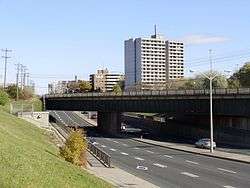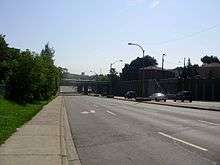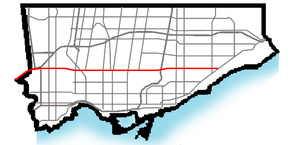Eglinton Avenue
| |||||||
|---|---|---|---|---|---|---|---|
|
Eglinton within Toronto | |||||||
| Route information | |||||||
|
Maintained by City of Toronto City of Mississauga | |||||||
| Major junctions | |||||||
| West end: |
| ||||||
|
Ninth Line Winston Churchill Boulevard Mavis Road Hurontario Street Kipling Avenue Islington Avenue Jane Street Black Creek Drive Keele Street Dufferin Street Allen Road Bathurst Street Avenue Road Yonge Street Bayview Avenue Leslie Street Don Mills Road Victoria Park Avenue Warden Avenue Kennedy Road Markham Road | |||||||
| East end: | Kingston Road | ||||||
| Location | |||||||
| Major cities: | Toronto, Mississauga | ||||||
| Highway system | |||||||
| |||||||

Eglinton Avenue is a major east-west arterial thoroughfare in Toronto and Mississauga, in the Canadian province of Ontario. Within Toronto, Eglinton Avenue is the only road which crosses through all six former municipalities. The road begins at 6th Line in Milton as Lower Baseline, becomes Eglinton Avenue as it crosses into Mississauga, then crosses through Toronto to end at Kingston Road. The section between the Etobicoke Creek and Renforth Drive forms the city limits of Toronto and Mississauga.
The Toronto section was surveyed in the 19th Century as the 4th Concession Road in relations to Lakeshore Road (Queen Street). It was historically known as Richview Sideroad in Etobicoke, Lower Baseline in Mississauga, and Highway 5A (later Highway 109) in Scarborough.
Route description
.jpg)
Eglinton Avenue runs through a number of neighbourhoods and is residential, for the most part, though it becomes a major commercial area from Allen Road to Don Mills Road. The Eglinton West area, which stretches from Oakwood–Vaughan to Keele Street, is home to a number of Caribbean and West Indian stores.
Eglinton Avenue is one of the few east-west routes north of Bloor Street that crosses Toronto uninterrupted in a more or less straight line across the entire city. Eglinton was also the only street to cross through all six municipalities that made up Metro Toronto: East York, Etobicoke, North York, Scarborough, Toronto, and York.
Sites along Eglinton


There are many notable sites and landmarks along Eglinton Avenue; they include the Erin Mills Town Centre, Centennial Park, Little Jamaica, the Eglinton Flats sports park,[1] Eglinton Park,[2] Yonge and Eglinton Centre, the Canada Square Complex, Sunnybrook Park, the TVOntario Headquarters, the Ontario Science Centre, the Eglinton Square Shopping Centre, The Golden Mile, and Toronto East Detention Centre.
History
There are two sources for the naming of Eglinton Avenue. Henry Scadding in an early history of the city wrote that it originated from Eglinton Castle in Scotland, itself named for the Earls of Eglinton. Several early settlers, impressed by the Eglinton Tournament of 1839 hosted by the 13th Earl, named the hamlet developing in the area as the Village of Eglinton after the Earl. More likely is the humbler story that it was named by the tavern keeper John Montgomery who settled in the area in 1830 and named the village after the Earl of Eglinton of the Montgomerie family, to whom he believed he had a family connection.[3]
The wagon trail connecting to Yonge between the third and fourth concessions soon adopted the name of the village, and was gradually improved over the years near Yonge Street. In 1890 the area was incorporated as North Toronto, and in 1912 it was annexed to Toronto itself. In 1953, Metropolitan Toronto (Metro) was formed. Seeking to build new connections to the rapidly developing suburbs, Metro widened and interconnected Eglinton to its current form through the decade.
The eastern segment through Scarborough was known as Highway 5A between 1937 and 1953; this number also appeared on St. Clair Avenue West until 1952 (when the Toronto Bypass opened between Weston and Highway 11). The two pieces of "Highway 5A" were never connected. In 1953, what remained was renumbered as Highway 109; a year later, the road was removed from the provincial highway system. Because of its time as a provincial highway, the road through Scarborough was widened considerably. A right of way was also acquired to bridge the gap in Eglinton. Until the mid-1950s, Eglinton did not cross either of the valleys of the Don River. The road ended at Brentcliffe and resumed at Victoria Park Avenue (then known as Dawes Road). The Department of Highways relinquished control of Highway 109 to the newly formed Metro government. Metro built the new section of Eglinton Avenue, first between Dawes Road and Don Mills Road in 1955, and later between Don Mills Road and Leaside in 1956.[4] The structure over the GO rail line and East Don River is known as the Harvey C. Rose Bridge, and honours the Chief engineer of the Toronto and York Roads Commission, later the Metropolitan Toronto Commission of Roads.[5]
Richview Expressway proposal
The western section ended at the Humber River until the 1970s. On the opposite side, Richview Sideroad followed the same alignment as far as the Toronto–Peel boundary. In 1943, city planner Norman Wilson indicated the possible future need for an new urban highway to connect Eglinton Avenue with the Richview Sideroad. These plans would mature into the Richview Expressway with the formation of Metropolitan Toronto in 1954. Part of the requirements for the Richview Expressway was staged construction of a parallel arterial road. This was approved in 1963, and construction began on Eglinton Avenue from west of Weston Road to Royal York Road. With its completion in 1970, the four-lane Richview Sideroad was renamed Eglinton Avenue West.[6]
In Toronto, the right-of-way to construct the Richview Expressway remains but the project has never come to fruition, save for high-speed ramps from Eglinton to Highway 401 and Highway 427 at that complicated interchange. Local opposition has made the proposed expressway unlikely, though the land remains owned by the city.
Future redesign
Once the Eglinton Crosstown line is completed by Metrolinx in 2020 the existing bus lanes on Eglinton between Black Creek Drive and Kennedy Road will no longer be needed, providing an opportunity to redesign the street. In 2014 the City of Toronto released a report proposing a redesign of the street to provide generally a four lane roadway over the underground LRT, with a three lanes (two traffic and centre turning lane) between Avenue Road and Mount Pleasant Road. The variation in number of lanes is based on lower car traffic volumes near Yonge Street. The redesign would also provide wider sidewalks and a continuous raised bicycle that would be the longest bike lane in the city. The initial implementation of the redesign would be carried out with the reconstruction at Crosstown line station locations that would be funded as part of the Crosstown line project. Reconstruction between stations will be funded by the city and is proposed to be carried out after completion of the Crosstown line so that this does not interfere with the Metrolinx construction activity.[7][8] A planning process called Eglinton Connects drew on public consultation to evaluate options for the redesign.[9]
Transit

The Eglinton West (at Allen Road), Eglinton (at Yonge Street), and Kennedy stations of the Toronto subway are located along Eglinton. The Toronto Transit Commission (TTC) operates bus routes 32 Eglinton West (between Eglinton station to the western city limits) and 34 Eglinton East (between Eglinton and Kennedy stations). East of Kennedy station, routes 86 Scarborough, 116 Morningside and 198 U of T Scarborough Rocket provide regular all-day service.
In Mississauga, MiWay route 35 Eglinton serves almost the entire length of the road, 34 Credit Valley serves the section west of Hurontario Street, and 7 Airport serves the section east of Hurontario; also sections of the road are served by routes 17 Timberlea, 89 Meadowvale-Subway and 109 Meadowvale Express during peak hours.
In Mississauga, a grade-separated bus rapid transit line is undergoing construction since November 2010. Of the 12 BRT stations being built, four of them are planned to be built along Eglinton Avenue: Etobicoke Creek, Spectrum, Orbitor and Renforth. All of these stations are located at the Airport Corporate Centre at the east end of Mississauga, just south of Toronto Pearson International Airport. Renforth Station will become a hub for TTC, GO Transit, and MiWay buses; meanwhile, the other three will be served exclusively by MiWay.
The provincial government of Bob Rae started the Eglinton West line in 1994, as a way of appeasing politicians in Etobicoke and York (as North York would receive Line 4 Sheppard), even though the official transit plan only recommended an Eglinton busway for the near future. The Eglinton subway was abandoned by Rae's successor Mike Harris, after a tunnel had been started from Eglinton West station.
The Eglinton Crosstown LRT, part of the TTC's Transit City light rail expansion program announced in 2007 called for an underground line to run from Jane Street to Laird Avenue, with above ground sections running to Pearson International Airport in the west and to Kennedy Station in Scarborough in the east. The provincial government's MoveOntario 2020 capital funding announcement in June 2007 funded the line.
Toronto mayor Rob Ford announced the cancellation of Transit City on the day that he took office.[10] The redesigned Eglinton–Scarborough Crosstown line along with a Line 4 Sheppard extension was announced four months later, with the support of Metrolinx and Ontario Premier Dalton McGuinty.[11]
The redesign put the 19 kilometres (12 mi) Eglinton portion completely underground, integrated the Scarborough RT portion, and would run contiguously from Black Creek Drive in the west to McCowan Road in the east. The redesign has since been shelved with construction plans reverting to the original design.
See also
References
- ↑ "Parks, Forestry and Recreation : Eglinton Flats". Toronto. Retrieved 29 August 2014.
- ↑ "Parks, Forestry and Recreation : Eglinton Park". Toronto. Retrieved 29 August 2014.
- ↑ F. R. Berchem. Opportunity Road: Yonge Street 1860-1939 Dundurn, 1996. pg. 91
- ↑ "Over 200,000,000 Added to Assessment Rolls in 55' Realtors Told". Toronto Star. February 5, 1955. p. 12.
- ↑ Annual Report, Department of Highways. 1956.
- ↑ Clark, M. "Historical Development". Review of the Richview Expressway. Metropolitan Toronto Transportation Plan Review. p. 10.
- ↑ Eglinton Connects – Environmental Assessment Study (PDF), City of Toronto, 25 March 2014, retrieved 1 July 2015
- ↑ "Eglinton LRT plan calls for $150 million in streetscaping" (PDF). Toronto Star. 11 April 2014. Retrieved 1 July 2015.
- ↑ . City of Toronto http://www1.toronto.ca/wps/portal/contentonly?vgnextoid=6c9e86664ea71410VgnVCM10000071d60f89RCRD. Retrieved 1 July 2015. Missing or empty
|title=(help) - ↑ Mayor Rob Ford: “Transit City is over” Toronto Life December 1, 2010
- ↑ "Funding questions linger after new transit plan announced" By Natalie Alcoba, National Post. March 31, 2011

